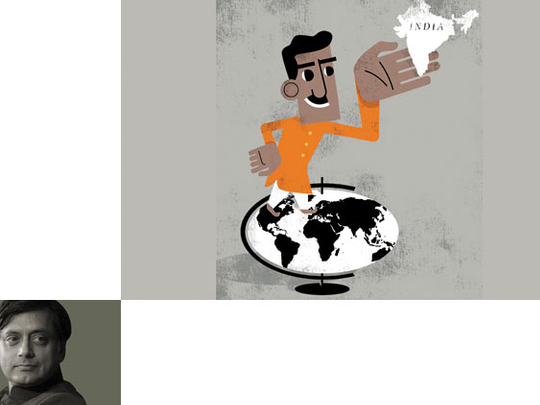
No other country has anything like it — an annual jamboree of its diaspora, conducted with great fanfare by its government. India has been doing it, with great success, for a decade, timed to recall the return to India of the most famous Indian expatriate of them all, Mahatma Gandhi, who alighted from his South African ship in Bombay [now Mumbai] on January 9, 1915. As I write, the southern port city of Kochi is overflowing with expatriate Indians celebrating their connection to their motherland.
India is the only country that has an official acronym for its expatriates — NRIs, or “Non-Resident Indians.” In my book India: From Midnight to the Millennium, I suggested, only half-jokingly, that the question is whether NRI should stand for “Not Really Indian” or “Never Relinquished India”.
Of course, the nearly 25 million people of Indian descent who live abroad fall into both categories. However, the 1,600 delegates who flocked to Kochi from 61 countries for the 11th Pravasi Bharatiya Divas (Expatriate Indians’ Day) celebrations from January 7-9 were firmly in the latter camp. They were in India to affirm their claim to it.
It was curiously appropriate that the event, organised by the Ministry for Overseas Indian Affairs (another unique Indian creation) in cooperation with the Federation of Indian Chambers of Commerce and Industry, took place in Kochi this year. After all, though the state of Kerala contains just 3 per cent of the country’s population, it accounts for the largest number of Indians living and working abroad.
And what a collection the delegates make: The President of Mauritius, the former governor-general of New Zealand, former prime ministers of Fiji and Guyana, Malaysian politicians, Gulf-based entrepreneurs, tycoons from Hong Kong and corporate titans from the US — all united by the simple fact of shared heritage — the undeniable reality that even exiles cannot escape the mirror. As Prime Minister Manmohan Singh put it in his inaugural address, they were united, too, by an “idea of Indianness”.
Indianness embodies the diversity and pluralism of both the country and its diaspora. India was again using the Pravasi Bharatiya Divas celebrations to provide Indians — including former Indians — from all corners of the world the assurance that they were indeed at home.
There have been four waves of Indian emigration. The first, in pre-colonial times, included those who left as travellers, teachers and traders; the second involved the forced migration of Indian labour as indentured servants of the British Empire; the third was the tragic displacement of millions by the horrors of partition; and now we have the contemporary phenomenon of skilled Indians seeking new challenges and opportunities in a globalised world.
I would probably divide the fourth wave further into two distinct categories: Highly educated Indians, often staying on after studies abroad in places like the US; and more modestly qualified (but often harder-working) migrants, from taxi drivers to shop assistants, who generally see their migration as temporary and who remit a larger share of their income to India than their higher-earning counterparts do. However, both sets of fourth-wave migrants remain closely connected to their motherland.
The ease of communications and travel today enables expatriates to be engaged with India in a way that was simply not available to the plantation worker in Mauritius or Guyana a century ago. To tap into this sense of allegiance and loyalty through an organised public gathering was an inspired idea, which India continues to build upon each year.
India regards its successful expatriates as a source of pride, support and investment. According to a recent US survey, Indian-American households’ median annual income is nearly $88,000 (Dh323,664), more than $12,000 higher than Japanese-American households and more than $20,000 higher than the national average. That kind of success is not merely at the elite end of the scale. In England today, Indian restaurants employ more people than the steel, coal and shipbuilding industries combined. (Many are the ways in which the Empire can strike back.)
The presence of successful and influential Indians in so many countries is also a source of direct support for India, as they influence not just popular attitudes, but also government policies, to the benefit of India. The country also received $70 billion in remittances last year — more than double the level of inward foreign direct investment.
There is undoubtedly a utilitarian aspect to the Pravasi Bharatiya Divas celebrations, as suggested by the many parallel seminars being run by state governments to attract expatriate investment. The importance of diaspora financing — from the remittances of working-class Indians that have transformed Kerala’s countryside to the millions poured into high-tech businesses in Bangalore or Gurgaon by Silicon Valley investors — simply cannot be minimised, especially during a global financial crisis.
Yet, one should not get carried away. Overseas Indians still invest a lower proportion of their resources in India than overseas Chinese do in China. Encouraging them to do more and giving them reasons to do more is certainly a worthwhile task for the Indian government — and an overt goal of the annual conclave.
Sometimes, the real value of a conference, however, lies in the conferring. Indians have learned to appreciate how much it means to allow NRIs from all over the world the chance to share their experiences, celebrate their commonalities, exchange ideas and swap business cards. Because when India allows its pravasis (expatriates) to feel at home, India itself is strengthened. I can think of one more meaning of NRI: the National Reserve of India.
— Project Syndicate, 2013
Shashi Tharoor is India’s Minister of State for Human Resource Development.







